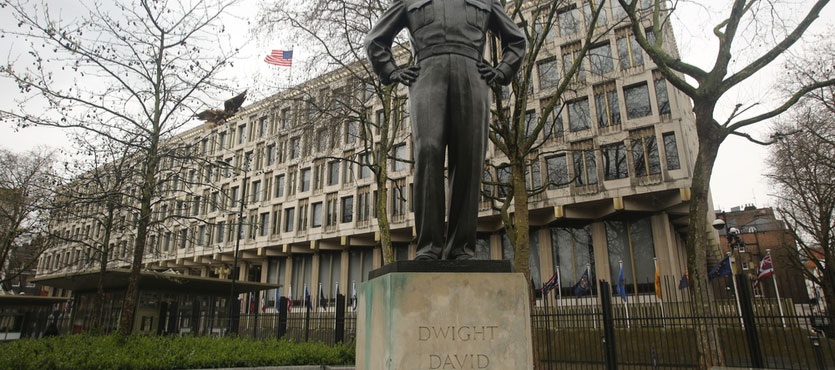An imposing structure that some pundits have dubbed the “sugar cube,” and also happens to be one of the costliest facilities of its kind, is set to open in January of 2018, thanks to an army of construction workers.
Considering infrastructure, construction, landscaping, and all other costs, the new United States Embassy in London, which is on the banks of the Thames, will cost about $1 billion. Some other embassy compounds, most notably the ones in Baghdad and Kabul, are more expensive, but that is due to operational security costs. The London embassy is high-security, as well, largely because of a 2011 law which mandates that all such facilities have a seclusion zone barrier that is at least 100 feet wide. Pennsylvania-based architectural firm KieranTimberlake, which designed the facility, hid some security features behind hedges and trees to make the facility more aesthetically pleasing. There is also a semicircular pond in front of the entrance, a feature that the British press was quick to label a moat. But that is not true, according to lead architect James Timberlake. “The water in this case is only in front of the building, incorporated into a public park, which is publicly accessible,” he explained.
As for the “sugar cube” moniker, the 12-story building does have a very distinctive look. It also has a number of advanced, eco-friendly features, such as internal lighting that is responsive to daylight, a rainwater retention system, and solar panels. Furthermore, the embassy is a hub of complete redevelopment project, as unused warehouses have been cleared for residential and retail space. The London underground has been expanded, as well.
Security needs had turned the old Grosvenor Square location, where the embassy has been since 1960, into a logistical nightmare and something of a neighborhood eyesore, given its vast array of perimeter fences, concrete barriers, and guardhouses.
Contractors in Western Europe
During the Cold War, most of Western Europe, except for parts of West Germany, was arguably one big rear area where both regular servicemembers and private military contractors faced very few risks, but that has changed radically. Just since 2014, there have been about three dozen major terrorist attacks in the region, including:
- A knife-wielding man repeatedly shouted “Allahu Akbar” as he fatally stabbed three people in a Tours police station,
- In a coordinated series of attacks that had reportedly been in the works for years, three gunmen killed 17 people in four separate Ile de France attacks,
- 89 people died in another coordinated series of Paris bombings that targeted a concert and a football match,
- A machete-wielding man injured three police officers in Brussels,
- Suicide bombers killed 32 people and injured 340 in Brussels,
- ISIS claimed responsibility after a Nice truck driver drove through Bastille Day crowds, killing 86 people and injuring almost 500,
- An attacker claimed he was “ready to die for Allah” right before he was shot by French soldiers guarding the Orly Airport, and
- Just a few blocks from the American Embassy in London, a man rumbled through pedestrians on Westminster Bridge, killing five people.
This is only a partial list. Furthermore, authorities in a number of countries say they disrupted almost as many terrorist plots before they could be carried out.
Disturbingly, some of these attacks were intricate operations that had been planned for years, while others were spur-of-the-moment acts of violence carried out by people with political motives. Contractors in Western Europe are completely exposed to danger from this double-edged sword.
Injury Compensation Available
Private contractors in all these countries are eligible for compensation under the Defense Base Act (DBA), assuming that they work pursuant to a contract with a U.S. government agency. Since each of these countries contains at least one U.S. military installation, all these countries are war zones under the DBA. These locations also meet the other eligibility prong, which is that they are not located within the borders of the United States.
Significantly, contractors need not be injured while on the clock or in the line of duty. Just like the Veterans Administration provides medical care to servicemembers if they are injured while deployed, almost regardless of the circumstances, DBA insurance companies pay benefits to injured contractors as long as their injuries have some relationship with their reason for being in-country.
Strict time deadlines apply in these cases. Specifically, victims must report their injuries in writing to their supervisors within 30 days. Although a more detailed report can be filed later, it is important for victims to make such reports as detailed as possible, including the names and contact information of any witnesses to the injury.
Next, a special division of the US Department of Labor informs the DBA insurance company about the claim. The Act is self-executing in nature which means that benefits should be extended without controversy. In instances where benefits are not extended voluntarily, after both sides review all the applicable documents including medical records and incident reports, many claims are picked up informally. Where benefits are not extended informally, claims may proceed to a hearing before an Administrative Law Judge, who makes a decision based on the evidence and the arguments of counsel.
To learn more about the kinds of benefits available, contact Barnett, Lerner, Karsen & Frankel. P.A.

